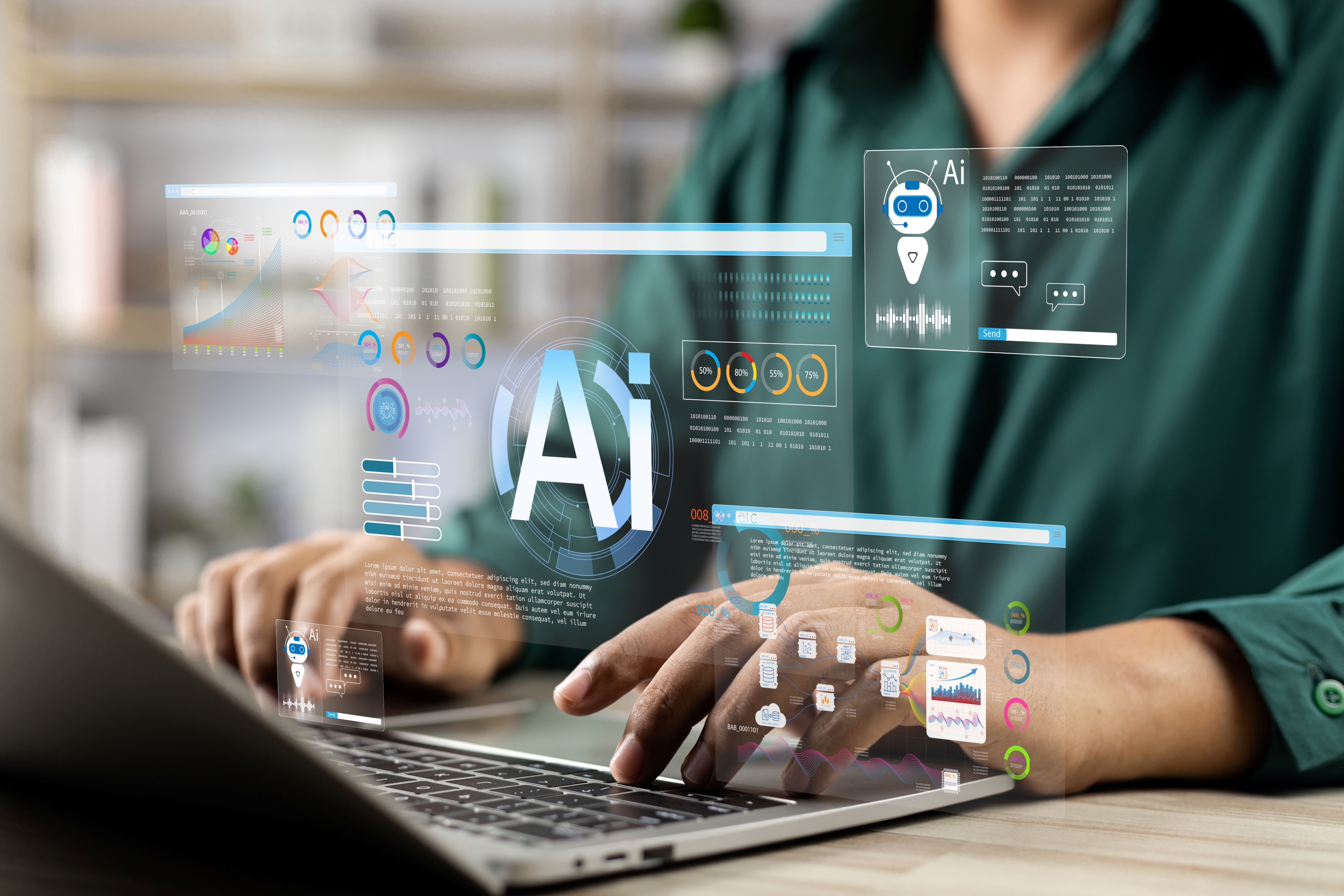Worried About an AI Bubble? Here’s What You Need to Know
Though AI is a transformative technology, it’s worth paying attention to the rising economic and financial risks. Here’s some guidance to navigate AI’s future.

To help you understand the trends surrounding AI and other new technologies and what we expect to happen in the future, our highly experienced Kiplinger Letter team will keep you abreast of the latest developments and forecasts. (Get a free issue of The Kiplinger Letter or subscribe.) You'll get all the latest news first by subscribing, but we will publish many (but not all) of the forecasts a few days afterward online. Here’s the latest…
It’s not easy to make sense of the artificial intelligence arms race. Astronomical sums are being spent on building AI data centers, with circular financing deals stoking bubble fears. It’s not yet clear how AI big spenders will make a return on their massive investment.
At the same time, demand for AI continues to outstrip supply. AI revenue is starting to pour in, as adoption by consumers and businesses rises swiftly. Meanwhile, Big Tech companies have mountains of cash and profitable business lines.
What gives? Generative AI is a true breakthrough, but risks related to overspending are on the rise. Meanwhile, a very large portion of recent U.S. economic growth and stock market gains comes from this AI spending.
The major worry is that today’s vast spending on AI data centers is nowhere near economically sustainable. To meet the expected demand for data centers, it will require $500 billion in annual global capex spending on new data centers, according to an analysis by Bain & Company, the management consulting giant.
AI companies will have to find $2 trillion in new yearly revenue by 2030 to arrive at an economically sustainable model. There could be an $800 billion shortfall if firms don’t find new and better ways to boost sales. Don’t mistake Bain as pessimistic, though, says David Crawford, a partner at Bain and chairman of its global Technology, Media & Telecommunications practice.
“We actually believe those things will happen,” Crawford says of finding new revenue. “We're extremely bullish on this trend.” He calls generative AI more significant than anything he’s seen working at Bain for 25 years. “We’re in for an extraordinary period of innovation.”
Of course, there are plenty of others who see the growing chasm between AI spending and revenue as the telltale sign of a bubble forming. That includes many people who agree that AI is a breakthrough technology with huge potential but worry that the hype is outpacing reality.
To drill down on the looming economic challenges, look no further than OpenAI, where sales are surging, but costs are rising faster. OpenAI reportedly will see sales of roughly $10 billion in 2025, a huge feat, since ChatGPT launched in 2022. It aims to make $100 billion by 2029, but it has plans to spend hundreds of billions over the next few years.
The start-up has a complex web of deals that includes a five-year contract to buy $300 billion in computing power from Oracle, and a deal for Nvidia to invest $100 billion in OpenAI. Nvidia’s financing the purchase of its own chips, along with other circular financing deals, has stoked bubble fears. OpenAI also has tie-ups with AMD and Broadcom for chips. Amid the massive future outlays, OpenAI has a private valuation of $500 billion, more than Samsung, Johnson & Johnson or Costco. And Alphabet, Amazon, Meta, Microsoft and others keep spending heavily in an arms race that requires ever more computing power to build leading AI tech.
Consider a few of the major risks we see:
- A lack of rational analysis over spending, notably from some Big Tech leaders who truly believe breakthrough superintelligence is around the corner. They think underinvesting is a bigger risk than overspending.
- Funding the AI build-out is getting less transparent. Meta and others are starting to finance deals via special-purpose vehicles and other transactions that are more opaque than normal capital expenditures. That trend is sure to grow.
- AI chips need to be replaced every three to five years and account for 50% of the spending to build data centers. Even with Goldman Sachs, BlackRock, Apollo and others lining up to finance deals, that replacement cycle requires much more AI revenue.
The capital that’s fueling AI’s ascent is money that can’t be put to other uses. And AI is swallowing up not just dollars, but human labor, including construction workers, electricians, HVAC specialists and IT pros needed to build data centers. Those trends drive up the cost of labor and supplies.
On the other hand, there are signs that this AI boom has staying power. Demand continues to outstrip supply for AI chips and AI computing power. OpenAI has 800 million users, showing how rapidly generative AI has been adopted. Revenue is growing swiftly, with generative AI set to reap $153 billion in revenue this year, according to a prediction by Morgan Stanley. That’s still far below capex spending, but up from zero in 2021.
Still, it’s hard to ignore the unfettered AI exuberance, including rising levels of FOMO (fear of missing out). Tech leaders, such as Jeff Bezos, even concede that some type of bubble is likely, but say it will pay off eventually. It’s hard to predict when AI excitement could cool or a pullback in spending could happen. For now, it looks like the pace of spending is set to continue for two years or more. That could unlock more opportunities with better AI tech, but also pose even more risks.
As overspending on AI occurs, one thing to keep a close eye on is AI revenue. Whole new major markets for AI are needed, beyond work software that merely boosts worker productivity.
From just $107.88 $24.99 for Kiplinger Personal Finance
Become a smarter, better informed investor. Subscribe from just $107.88 $24.99, plus get up to 4 Special Issues

Sign up for Kiplinger’s Free Newsletters
Profit and prosper with the best of expert advice on investing, taxes, retirement, personal finance and more - straight to your e-mail.
Profit and prosper with the best of expert advice - straight to your e-mail.
This forecast first appeared in The Kiplinger Letter, which has been running since 1923 and is a collection of concise weekly forecasts on business and economic trends, as well as what to expect from Washington, to help you understand what’s coming up to make the most of your investments and your money. Subscribe to The Kiplinger Letter.
Related Content
- Will AI Videos Disrupt Social Media?
- 10 Major AI Companies You Should Know
- What Is AI? Artificial Intelligence 101
- How Consumers Are Tinkering with Cutting-Edge AI
Profit and prosper with the best of Kiplinger's advice on investing, taxes, retirement, personal finance and much more. Delivered daily. Enter your email in the box and click Sign Me Up.

John Miley is a Senior Associate Editor at The Kiplinger Letter. He mainly covers AI, technology, telecom and education, but will jump on other business topics as needed. In his role, he provides timely forecasts about emerging technologies, business trends and government regulations. He also edits stories for the weekly publication and has written and edited email newsletters.
He holds a BA from Bates College and a master’s degree in magazine journalism from Northwestern University, where he specialized in business reporting. An avid runner and a former decathlete, he has written about fitness and competed in triathlons.
-
 4 Great Tools to DIY Your Own Financial Plan
4 Great Tools to DIY Your Own Financial PlanSmart Savings Several tools picked out by Kiplinger that DIYers can use to make their own financial plan.
-
 The 7-Month Deadline That Sets Your Lifetime Medicare Premiums
The 7-Month Deadline That Sets Your Lifetime Medicare PremiumsUnderstanding Medicare enrollment is crucial, as missing deadlines can lead to permanent late enrollment penalties and gaps in coverage.
-
 Retirees Living in Portugal: You Need a Post-NHR Tax Strategy
Retirees Living in Portugal: You Need a Post-NHR Tax StrategyWhen your 10-year Non-Habitual Resident tax break ends, you could see your tax rate soar. Take steps to plan for this change well before the NHR window closes.
-
 AI Appliances Aren’t Exciting Buyers…Yet
AI Appliances Aren’t Exciting Buyers…YetThe Kiplinger Letter Artificial intelligence is being embedded into all sorts of appliances. Now sellers need to get customers to care about AI-powered laundry.
-
 What to Expect from the Global Economy in 2026
What to Expect from the Global Economy in 2026The Kiplinger Letter Economic growth across the globe will be highly uneven, with some major economies accelerating while others hit the brakes.
-
 The AI Boom Will Lift IT Spending Next Year
The AI Boom Will Lift IT Spending Next YearThe Kiplinger Letter 2026 will be one of strongest years for the IT industry since the PC boom and early days of the Web in the mid-1990s.
-
 Amid Mounting Uncertainty: Five Forecasts About AI
Amid Mounting Uncertainty: Five Forecasts About AIThe Kiplinger Letter With the risk of overspending on AI data centers hotly debated, here are some forecasts about AI that we can make with some confidence.
-
 How to Read a Company's Balance Sheet Like a Stock Pro
How to Read a Company's Balance Sheet Like a Stock ProKnowing how to read this financial statement can help you separate strong companies from struggling ones.
-
 How to Choose the Best Charities to Donate To
How to Choose the Best Charities to Donate ToWhile you set your giving strategy, think about your values, and select organizations that will put your contributions to good use.
-
 Will AI Videos Disrupt Social Media?
Will AI Videos Disrupt Social Media?The Kiplinger Letter With the introduction of OpenAI’s new AI social media app, Sora, the internet is about to be flooded with startling AI-generated videos.
-
 What Services Are Open During the Government Shutdown?
What Services Are Open During the Government Shutdown?The Kiplinger Letter As the shutdown drags on, many basic federal services will increasingly be affected.